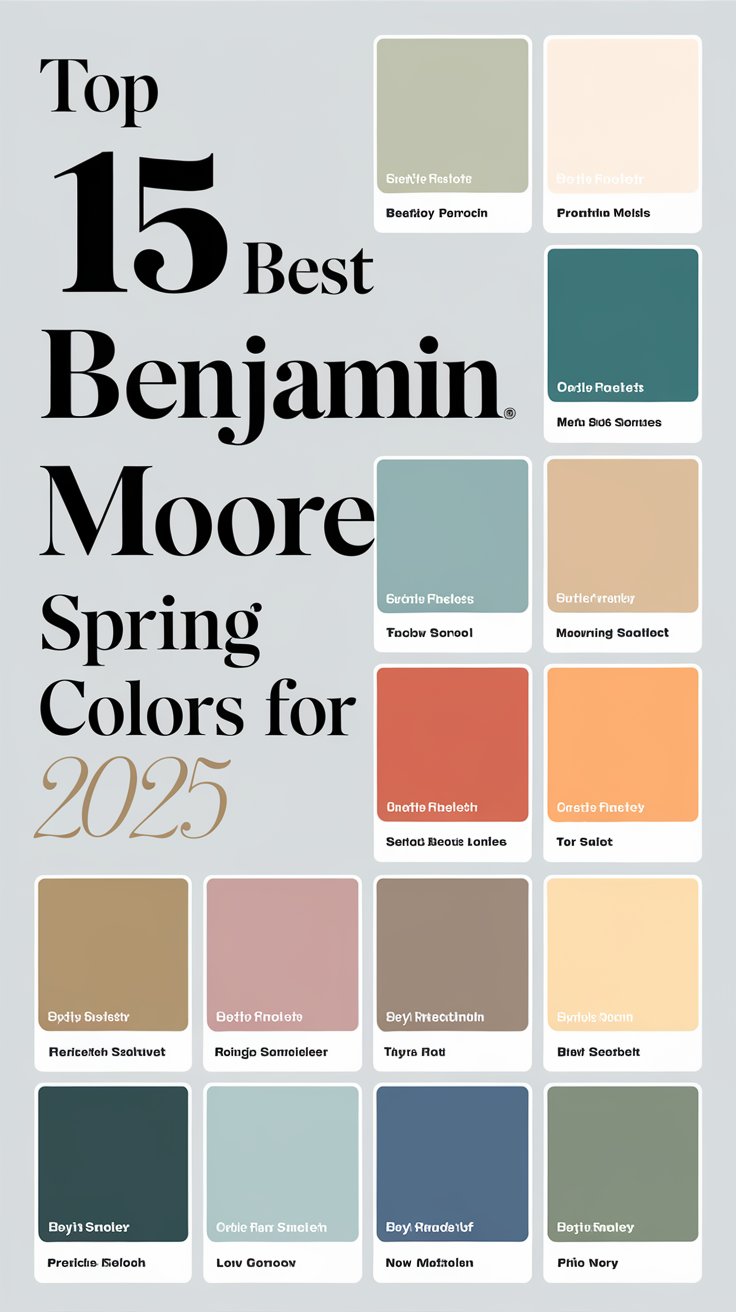Discover the secrets to perfectly arranging your bedroom furniture for ultimate comfort and style. Let’s transform your space!
**
How do you arrange your bedroom furniture?
**
My Lovely Spring Paint for 2025
Ready for a Spring Makeover? Explore the Freshest 2025 Paint Trends!
White Sage/Green SW Pistachio green Soft blue Honeysweet/Orange Pink Sugar Sage Tint BMAs an Amazon Associate, I may earn a commission from qualifying purchases at no extra cost to you.
**
As a daily routine with an interior designer:**
Arranging bedroom furniture is essential for a balanced and appealing look. Start by measuring the room and the furniture to ensure a good fit. Plan the layout to maximize space and functionality. Consider traffic flow and access to windows and doors. Use color matching for walls and furniture to create a cohesive look. Choose a focal point and design around it. Keep furniture proportions in mind and maintain a proper balance. Lastly, organize items with purpose and avoid clutter to create a relaxing bedroom atmosphere.
Interiors play a crucial role in home decorating. A well-planned space can enhance the overall aesthetic and functionality of your home. Interior designers can provide valuable insights into space planning, color matching, and furniture arrangement. They help create a cohesive look that reflects your style and preferences.
My fAV Spring DECOR for 2025
Discover Spring’s Best 2025 Decor Combinations – Perfect for Any Room!
Oversized Indoor Plants White Curved Sofas Rugs BOH Brown Cream Moroccan Hype Boho Rug Outdoor Patio Furniture Sets Topfinel Pillow CoversAs an Amazon Associate, I may earn a commission from qualifying purchases at no extra cost to you.
In the bedroom, focus on creating a tranquil environment for rest and relaxation. Consider using calming colors like blue or green and soft fabrics for bedding. Proper lighting can also enhance the ambiance. Organize your closet and dressers to keep everything neat and easily accessible.
A well-designed bedroom promotes better sleep and relaxation. By working with an interior designer, you can transform your space into a cozy retreat that meets your needs and reflects your personality.
How do I arrange my bedroom furniture for optimal space utilization?
When arranging your bedroom furniture for optimal space utilization, consider the following key points:
1. Begin by measuring the dimensions of your bedroom to ensure that your furniture pieces fit comfortably without overcrowding the space.
2. Place the bed against the longest wall to maximize floor space in the room.
3. Consider opting for a bed with built-in storage options such as drawers or shelves to eliminate the need for additional furniture pieces.
4. Use multipurpose furniture such as a bedside table that doubles as a desk or a storage ottoman at the foot of the bed.
5. Arrange the furniture in a way that allows for ease of movement around the room, ensuring that there are clear pathways.
6. Consider the natural light sources in the room and position the furniture to make the most of them.
7. Avoid cluttering the room with too many furniture pieces; less is often more when it comes to optimizing space utilization.
What is the best layout for a small bedroom with limited space?
In a small bedroom with limited space, the best layout is one that maximizes functionality and aesthetics:
1. Opt for a platform bed with built-in storage to save space that would otherwise be taken up by a separate dresser.
2. Consider wall-mounted shelves or bedside tables to free up floor space and create a sense of openness.
3. Use light, neutral colors on the walls and furniture to make the room appear larger and brighter.
4. Place the bed against a wall to open up the center of the room for movement and other furniture pieces.
5. Incorporate a mirror into the room’s design to create the illusion of more space.
6. Utilize vertical space with tall bookcases or wardrobes for additional storage without sacrificing floor space.
7. Opt for furniture pieces with clean lines and a streamlined design to create a cohesive and uncluttered look in the room.
Can I mix and match different styles of furniture in my bedroom?
Mixing and matching different styles of furniture in your bedroom can create a visually interesting and eclectic look:
1. Start by identifying the dominant style or theme you want to achieve in the room.
2. Choose one key element, such as the bed frame or dresser, to serve as a focal point for the room’s design.
3. Introduce elements of other styles through accent pieces like chairs, lamps, or decorative items.
4. Look for common elements such as color or material to tie the different furniture pieces together.
5. Experiment with contrast by pairing pieces from different styles that complement each other.
6. Consider the scale and proportions of the furniture to ensure they harmonize well within the room.
7. Trust your instincts and have fun with the process of mixing and matching different furniture styles to create a space that reflects your personality.
How can I create a cohesive look with different furniture pieces in my bedroom?
Creating a cohesive look with different furniture pieces in your bedroom involves careful planning and attention to detail:
1. Establish a color palette that ties together the different furniture pieces in the room.
2. Choose a unifying theme or style that guides your furniture selection process.
3. Incorporate elements of repetition, such as similar shapes or patterns, to create visual harmony.
4. Balance the scale and proportions of the furniture pieces to ensure they work together seamlessly.
5. Consider the flow of the room and arrange the furniture in a way that promotes a sense of unity.
6. Add coordinating accessories like throw pillows, rugs, and artwork to enhance the cohesive look.
7. Avoid overcrowding the space with too many furniture pieces; focus on quality over quantity for a polished and cohesive aesthetic.
What color schemes work best when arranging bedroom furniture?
When arranging bedroom furniture, consider the following color schemes for a harmonious and inviting space:
1. Neutral colors like white, beige, or gray create a calming and versatile backdrop for various furniture styles.
2. Pastel hues such as soft blue, pink, or lavender lend a soothing and feminine touch to the room.
3. Monochromatic schemes in shades of a single color add depth and interest without overwhelming the space.
4. Warm tones like earthy browns, terracotta, or mustard create a cozy and inviting atmosphere in the bedroom.
5. Complementary color schemes, such as blue and orange or green and pink, offer a dynamic and visually appealing contrast.
6. Consider the natural light in the room when selecting colors to ensure they complement each other and enhance the overall ambiance.
7. Strategic pops of color through accent furniture pieces or accessories can inject personality and vibrancy into the space without overpowering it.
How can I incorporate storage solutions into my bedroom furniture arrangement?
To maximize storage in your bedroom furniture arrangement, consider the following strategies:
1. Choose furniture pieces with built-in storage options such as drawers, shelves, or compartments.
2. Opt for a bed frame with under-bed storage for linens, bedding, or out-of-season clothing.
3. Utilize vertical space with tall wardrobes, armoires, or bookcases to store clothing, shoes, and accessories.
4. Invest in multifunctional furniture like a storage ottoman or a bench with hidden compartments for added storage.
5. Use wall-mounted shelves or floating nightstands to keep essentials within reach without cluttering the floor.
6. Consider customizing your furniture pieces to incorporate hidden storage solutions that suit your specific needs.
7. Keep an organized system for categorizing and storing items in your bedroom furniture to maintain a clean and clutter-free space.
What are some alternative paint colors that complement different furniture styles in a bedroom?
When selecting paint colors to complement different furniture styles in your bedroom, consider the following alternatives:
1. Soft sage green or muted olive tones pair well with natural wood furniture for a serene and earthy look.
2. Pale blush pink or dusty rose hues create a romantic and elegant backdrop for vintage or eclectic furniture pieces.
3. Navy blue or deep indigo shades provide a sophisticated and dramatic contrast to light-colored or contemporary furniture.
4. Terracotta or burnt orange colors add warmth and richness to a room with mid-century modern or bohemian furniture styles.
5. Charcoal gray or slate tones offer a modern and versatile option that pairs seamlessly with both light and dark furniture finishes.
6. Creamy off-white or ivory shades provide a timeless and classic base for traditional or rustic furniture pieces.
7. Consider experimenting with bold accent walls in jewel tones like emerald green, sapphire blue, or amethyst purple to make a statement and showcase specific furniture items in the room.
Key Takeaways
– Optimize space utilization in your bedroom by measuring dimensions, using multipurpose furniture, and creating clear pathways.
– Maximize functionality in a small bedroom by choosing space-saving furniture, utilizing vertical storage, and incorporating light colors.
– Mix and match different furniture styles by establishing a dominant theme, tying elements together with color or material, and experimenting with contrast.
– Create a cohesive look with different furniture pieces by selecting a unifying color palette, balancing scale and proportion, and adding coordinating accessories.
– Choose color schemes wisely when arranging bedroom furniture, considering neutrals, pastels, monochromatic options, warm tones, complementary contrasts, and strategic pops of color.
– Incorporate storage solutions into your bedroom furniture arrangement by selecting pieces with built-in storage, utilizing vertical space, investing in multifunctional furniture, and maintaining an organized system.
– Explore alternative paint colors to complement different furniture styles, such as soft green with natural wood, blush pink with vintage pieces, navy blue with contemporary furniture, terracotta with mid-century modern items, charcoal gray with varied finishes, and cream tones with traditional furniture.
By following these strategies and incorporating these ideas into your bedroom furniture arrangement, you can create a functional, visually appealing, and personalized space that meets your needs and reflects your style.







